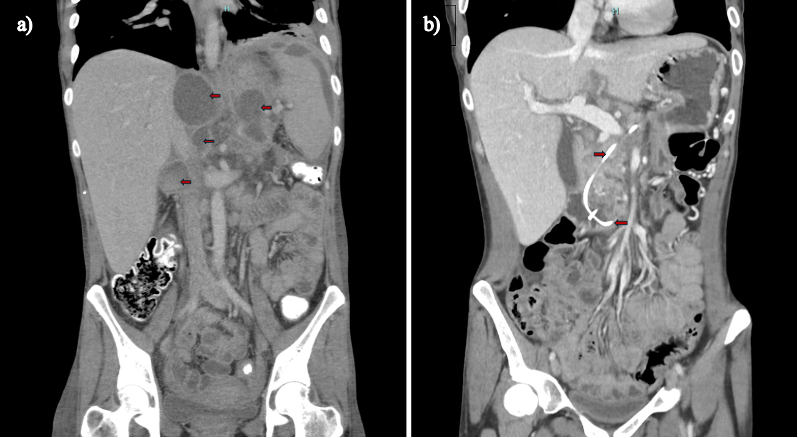Monday Poster Session
Category: Interventional Endoscopy
P3562 - Multifocal Pancreatic Pseudocysts With Multifocal Pancreatic Duct Leak: A Role for Transpapillary Drainage
Monday, October 27, 2025
10:30 AM - 4:00 PM PDT
Location: Exhibit Hall

Tushaar V. Shrimanker, MD, MRCP (he/him/his)
University of Massachusetts Chan Medical School-Baystate Medical Center
Enfield, CT
Presenting Author(s)
Tushaar V. Shrimanker, MD, MRCP1, Syed Hamza Sohail, MD2, Cristina Batarseh, MD3, Aizaz Khan, MD2, Tiago Martins, DO2, Kevin Groudan, MD4, Nha Duong, DO5
1University of Massachusetts Chan Medical School-Baystate Medical Center, Enfield, CT; 2University of Massachusetts Chan Medical School - Baystate Health, Springfield, MA; 3University of Massachusetts Chan Medical School-Baystate Medical Center, Chicopee, MA; 4University of Massachusetts Chan Medical School - Baystate Health, East Windsor, CT; 5University of Massachusetts Chan Medical School-Baystate Medical Center, Granby, CT
Introduction: Pancreatic pseudocysts are a known complication of pancreatitis. In rare cases, persistent or recurrent fluid collections may result from pancreatic duct (PD) disruption with leaks. This case highlights multifocal pseudocysts with suspected multifocal PD leak in a transgender male with alcohol-associated pancreatitis, leading to pancreatic ascites, bacterial peritonitis, and IVC compression.
Case Description/
Methods: A 37-year-old transgender male with alcohol use disorder presented with epigastric pain. CT imaging revealed acute-on-chronic pancreatitis with large pseudocysts causing mass effect on the portal-splenic confluence and biliary ductal narrowing, with small-volume ascites (Figure 1a).
He was initially managed conservatively, but symptoms persisted with worsening collections, ascites, and signs of secondary bacterial peritonitis. Paracentesis confirmed pancreatic ascites (elevated lipase, low SAAG) with neutrophilic leukocytosis and growth of Streptococcus mitis. EUS identified two large pseudocysts; a 5.5 x 5 cm cyst near the antrum was drained using a lumen-apposing metal stent (LAMS). A second 5.5 cm cyst compressing the intrahepatic IVC was aspirated via FNA but reaccumulated after 2 days.
Due to incomplete resolution of cysts, endoscopic retrograde pancreatography (ERP) was performed and revealed PD leaks near the neck of the pancreas (Figure 2a). A 5Fr x 5 cm PD stent was subsequently placed. Despite initial improvement in ascites, the collections worsened. Repeat ERP showed contrast pooling into a large cyst and gastric opacification (Figure 2b), suggesting a fistula from prior cystgastrostomy to the PD and persistent leak into an upstream cyst. A longer 7Fr x 15 cm double-pigtail stent was placed into the pseudocyst to enable transpapillary drainage (Figure 2c), bridging multiple leak sites. A CT at 3 months showed complete resolution (Figure 1b).
Discussion: While LAMS is effective for individual collections, transpapillary drainage should be considered for persistent or recurrent multifocal fluid collections unresponsive to standard drainage. There is limited data to support a combined transmural-transpapillary approach1, but it may be useful for large upstream pseudocysts and downstream PD leaks, allowing both cyst drainage and ductal bridging.

Figure: Figure 1 a) Coronal CT image of multiple pseudocyst collections b) Long 7Fr x 15cm pancreatic duct double pigtail stent and resolution of pseudocysts.

Figure: Figure 2 a) Pancreatogram indicating leak near neck of pancreas. b) Pancreatogram demonstrating contrast in cyst and stomach with presence of LAMS, and persisting leak near neck of pancreas. c) Long double pigtail stent in pancreatic duct, terminating in cyst.
Disclosures:
Tushaar Shrimanker indicated no relevant financial relationships.
Syed Hamza Sohail indicated no relevant financial relationships.
Cristina Batarseh indicated no relevant financial relationships.
Aizaz Khan indicated no relevant financial relationships.
Tiago Martins indicated no relevant financial relationships.
Kevin Groudan indicated no relevant financial relationships.
Nha Duong indicated no relevant financial relationships.
Tushaar V. Shrimanker, MD, MRCP1, Syed Hamza Sohail, MD2, Cristina Batarseh, MD3, Aizaz Khan, MD2, Tiago Martins, DO2, Kevin Groudan, MD4, Nha Duong, DO5. P3562 - Multifocal Pancreatic Pseudocysts With Multifocal Pancreatic Duct Leak: A Role for Transpapillary Drainage, ACG 2025 Annual Scientific Meeting Abstracts. Phoenix, AZ: American College of Gastroenterology.
1University of Massachusetts Chan Medical School-Baystate Medical Center, Enfield, CT; 2University of Massachusetts Chan Medical School - Baystate Health, Springfield, MA; 3University of Massachusetts Chan Medical School-Baystate Medical Center, Chicopee, MA; 4University of Massachusetts Chan Medical School - Baystate Health, East Windsor, CT; 5University of Massachusetts Chan Medical School-Baystate Medical Center, Granby, CT
Introduction: Pancreatic pseudocysts are a known complication of pancreatitis. In rare cases, persistent or recurrent fluid collections may result from pancreatic duct (PD) disruption with leaks. This case highlights multifocal pseudocysts with suspected multifocal PD leak in a transgender male with alcohol-associated pancreatitis, leading to pancreatic ascites, bacterial peritonitis, and IVC compression.
Case Description/
Methods: A 37-year-old transgender male with alcohol use disorder presented with epigastric pain. CT imaging revealed acute-on-chronic pancreatitis with large pseudocysts causing mass effect on the portal-splenic confluence and biliary ductal narrowing, with small-volume ascites (Figure 1a).
He was initially managed conservatively, but symptoms persisted with worsening collections, ascites, and signs of secondary bacterial peritonitis. Paracentesis confirmed pancreatic ascites (elevated lipase, low SAAG) with neutrophilic leukocytosis and growth of Streptococcus mitis. EUS identified two large pseudocysts; a 5.5 x 5 cm cyst near the antrum was drained using a lumen-apposing metal stent (LAMS). A second 5.5 cm cyst compressing the intrahepatic IVC was aspirated via FNA but reaccumulated after 2 days.
Due to incomplete resolution of cysts, endoscopic retrograde pancreatography (ERP) was performed and revealed PD leaks near the neck of the pancreas (Figure 2a). A 5Fr x 5 cm PD stent was subsequently placed. Despite initial improvement in ascites, the collections worsened. Repeat ERP showed contrast pooling into a large cyst and gastric opacification (Figure 2b), suggesting a fistula from prior cystgastrostomy to the PD and persistent leak into an upstream cyst. A longer 7Fr x 15 cm double-pigtail stent was placed into the pseudocyst to enable transpapillary drainage (Figure 2c), bridging multiple leak sites. A CT at 3 months showed complete resolution (Figure 1b).
Discussion: While LAMS is effective for individual collections, transpapillary drainage should be considered for persistent or recurrent multifocal fluid collections unresponsive to standard drainage. There is limited data to support a combined transmural-transpapillary approach1, but it may be useful for large upstream pseudocysts and downstream PD leaks, allowing both cyst drainage and ductal bridging.

Figure: Figure 1 a) Coronal CT image of multiple pseudocyst collections b) Long 7Fr x 15cm pancreatic duct double pigtail stent and resolution of pseudocysts.

Figure: Figure 2 a) Pancreatogram indicating leak near neck of pancreas. b) Pancreatogram demonstrating contrast in cyst and stomach with presence of LAMS, and persisting leak near neck of pancreas. c) Long double pigtail stent in pancreatic duct, terminating in cyst.
Disclosures:
Tushaar Shrimanker indicated no relevant financial relationships.
Syed Hamza Sohail indicated no relevant financial relationships.
Cristina Batarseh indicated no relevant financial relationships.
Aizaz Khan indicated no relevant financial relationships.
Tiago Martins indicated no relevant financial relationships.
Kevin Groudan indicated no relevant financial relationships.
Nha Duong indicated no relevant financial relationships.
Tushaar V. Shrimanker, MD, MRCP1, Syed Hamza Sohail, MD2, Cristina Batarseh, MD3, Aizaz Khan, MD2, Tiago Martins, DO2, Kevin Groudan, MD4, Nha Duong, DO5. P3562 - Multifocal Pancreatic Pseudocysts With Multifocal Pancreatic Duct Leak: A Role for Transpapillary Drainage, ACG 2025 Annual Scientific Meeting Abstracts. Phoenix, AZ: American College of Gastroenterology.
